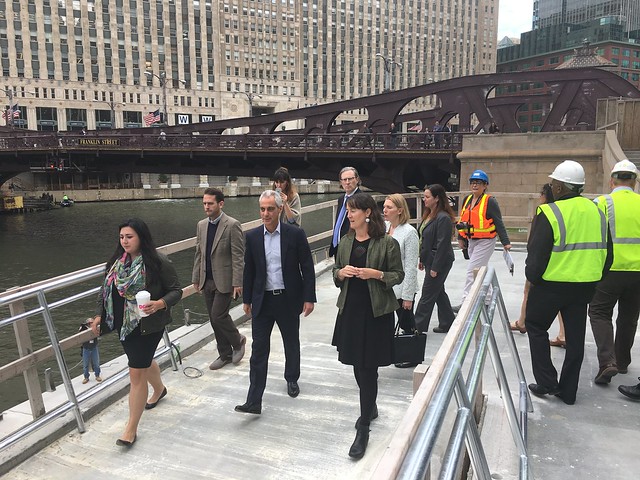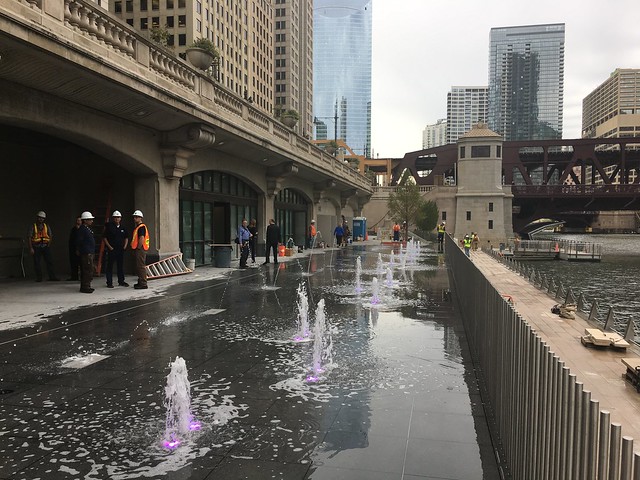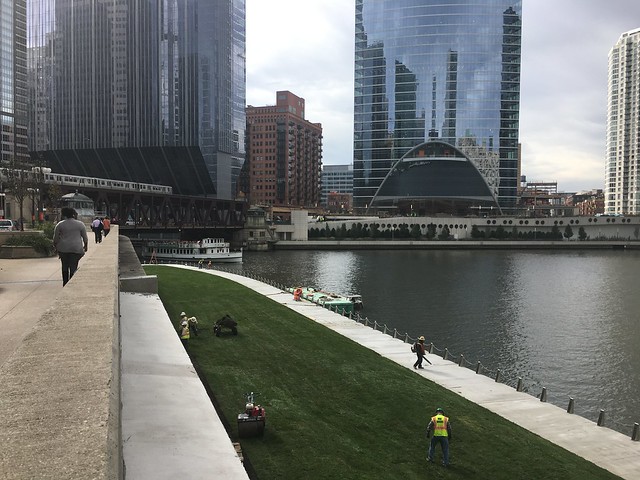
If all goes well, starting this weekend you’ll be able to walk most of the way from the Ogilvie Center to Michigan Avenue on a car-free, if somewhat circuitous, route. At a media preview of the final section of the Chicago Riverwalk expansion this afternoon, Mayor Emanuel said he’s confident that the new recreational space, which doubles as a corridor for walking and (cautious) biking, will be open to the public this Saturday.
Previously, the Chicago Riverwalk was a simple paved path that ran from the Lakefront Trail to State. The first segment of the riverwalk extension, a much more elaborate promenade from State to LaSalle, opened in summer 2015 and immediately proved a hit with locals and tourists alike. This latest segment will run from LaSalle to Lake, creating a 1.3-mile route from Lake Michigan to the West Loop.
Emanuel was joined on the tour by officials from the city’s transportation and fleet and facilities management departments, as well as downtown alderman Brendan Reilly (42nd Ward) and staff from Sasaki and Ross Barney Architects, the lead design team. The transportation department is building the project, which involved extending the south bank of the Chicago River out by 25 feet.
The three new sections, or “rooms,” of the Riverwalk to open later this week include:
- The Water Plaza: A water play area for children and their families at the river’s edge. (From LaSalle to Wells.)
- The Jetty: A series of piers and floating wetland gardens with interactive learning about the ecology of the river, including opportunities for fishing and identifying native plants. (From Wells to Franklin.)
- The Riverbank: A wheelchair-friendly ramp and new marine edge that creates access to Lake Street and features a public lawn at the confluence of the Main, North, and South branches of the river. The ramp provides an accessible route from lower to upper Wacker and Lake Street. (From Franklin to Lake.)

The $98 million riverwalk extension was financed through the U.S. Department of Transportation’s Transportation Infrastructure Finance Innovation Act (TIFIA) loan program. The project also received $10 million in state funding. The city plans to pay the loan off over the next few decades via docking fees, rent from the restaurants and kayak rentals, and taxes from boat tour tickets.
During the press event, Emanuel said the Chicago River was formerly a polluted eyesore, which Chicago has turned its back on since the turn of the 20th Century. But, he added, as the city works to clean up the river, projects like the extension will help the waterway live up to its potential as a recreational and retail facility. Emanuel likened the riverwalk to three other projects that converted outdated transportation spaces to park space: the new park on Northerly Island (built on the former Meigs Field airport site) and the Bloomingdale Trail and Maggie Daley Park (former freight railroad lines).
Asked what the economic impact of the riverwalk extension has been so far, Emanuel brought up the Vista Tower -- the largest investment of a Chinese developer in the U.S. – and the development of office buildings on Wolf Point as projects that were partly inspired by the impending construction of the riverwalk extension.





